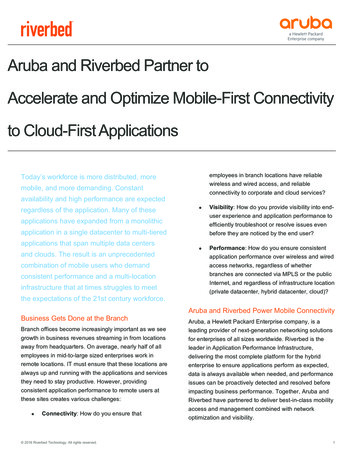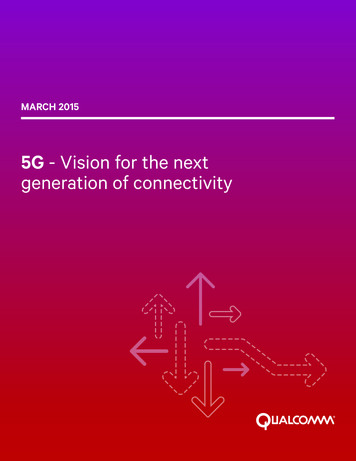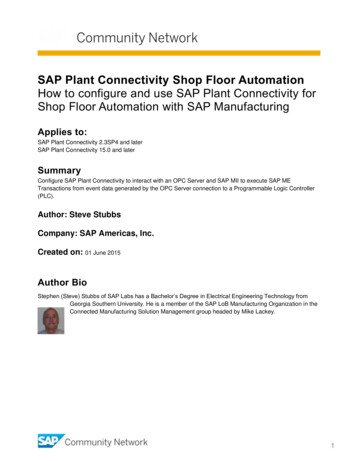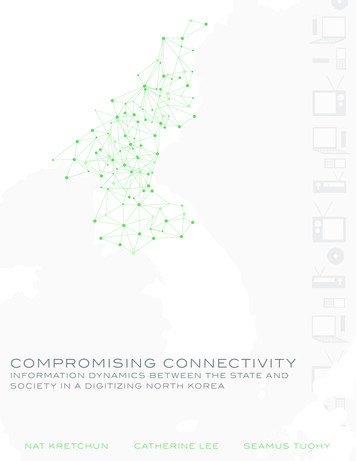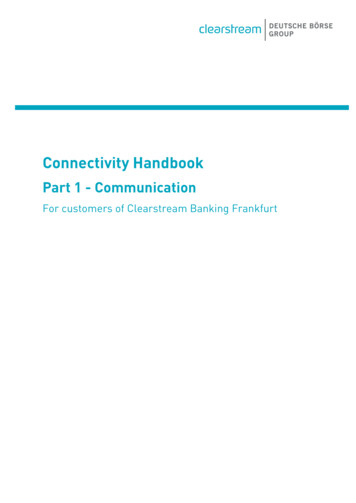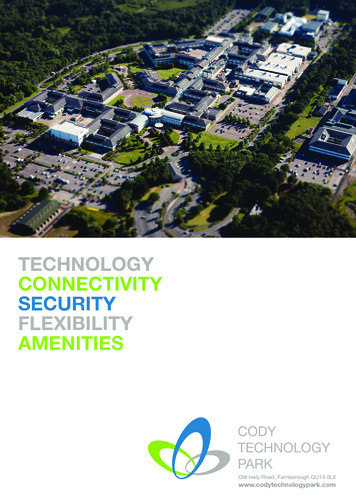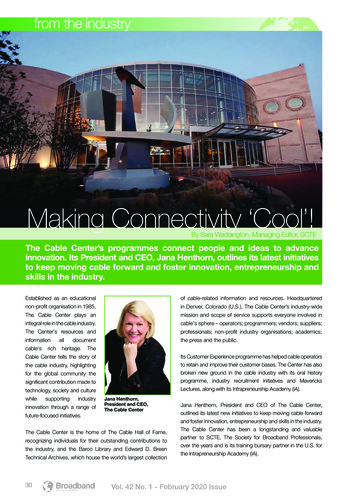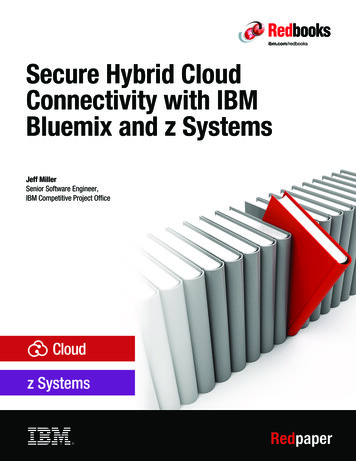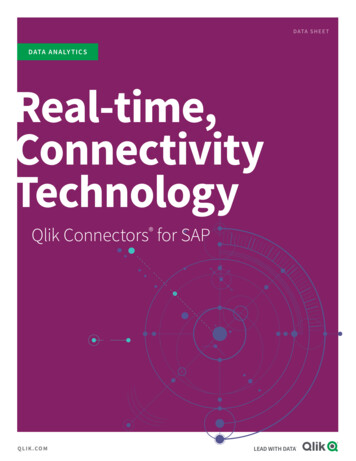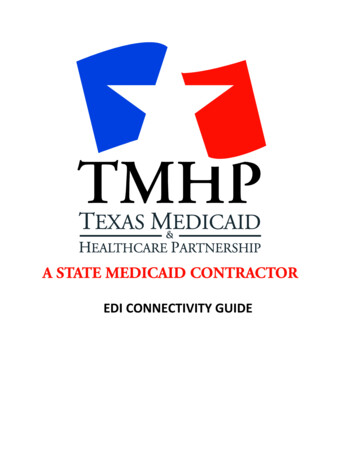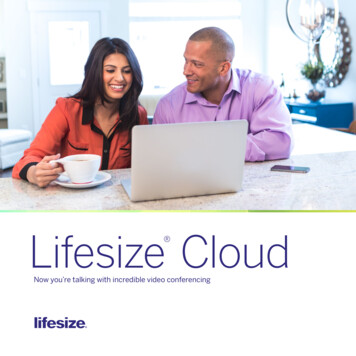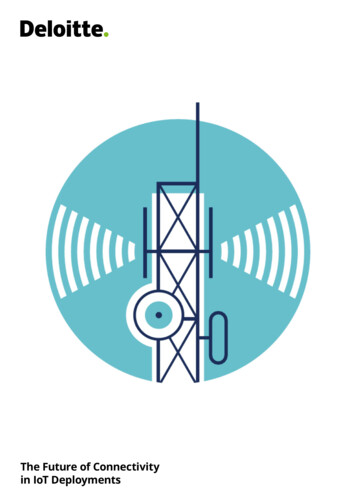
Transcription
The Future of Connectivityin IoT Deployments
Investing in Germany A guide for Chinese businesses 02
The Future of Connectivity in IoT DeploymentsIoT & Connectivity04Market Overview07IoT Connectivity Use Cases13Long Term Implications17Business Implications18Summary1903
Investing in Germany A guide for Chinese businesses IoT & ConnectivityLike a wildfire racing across the dry prairie, the Internet ofThings (IoT) is expanding rapidly and relentlessly. It soundslike an incredibly complex, but putting it in simple words, theInternet of Things (IoT) is nothing but a network that connectsphysical objects, such as vehicles, machine tools, streetlights, wearables, wind turbines, people, and other devices,via connectivity solutions in order to enable communication,exchange data, and derive actions.With the underlying goal of having accessto relevant information in real time (or atleast near real time), IoT sensors transform analog inputs into digital signals andthus create a digital reflection of whatis happening in the physical world. Thissetup enables the development of intelligent applications and services and allowsobjects to be sensed and actuated acrossexisting network infrastructures.Developments in the IoT field happen at abreathtaking pace, and IoT is the source ofmany promising business opportunities,which are expected to result in yet unimaginable increases in efficiency, accuracy,and economic benefits across organizations, industries, and markets. Moreover,IoT leads to new business models, movingthe focus from products to services.The number of physical objects that areconnected via the Internet of Thingsincreases at a tearing speed. Gartner,Inc. estimates that 8.4 billion connectedthings will be in use worldwide by the endof 2017, up 31 percent from 2016, andthat the number will reach 20.4 billion by2020.1 Dell’s CEO estimates that as manyas 70 billion connected devices will existby 2020.2As IoT grows, so do the volumes of dataproduced by some estimates, connecteddevices will generate 507.5 Zettabytes(ZB) of data per year (42.3 ZB per month)by 2019, up from 134.5 ZB per year (11.2ZB per month) in 2014. (a Zettabyte is1 trillion Gigabytes). Globally, the datacreated by IoT devices in 2019 will be 269times greater than the data being transmitted to data centers from end-userdevices and 49 times higher than totaldata center traffic.3 Currently, only 30% ofthe data created in areas like the supplychain is leveraged for optimization, but itis expected that this number will increasesignificantly in the future.Gartner Press Release Feb 07, 2017Marketplace.org By 2020 there will be 10 web-connected devices per human3Deloitte Tech Trends 20161204
The Future of Connectivity in IoT DeploymentsLooking at this incredible increase in global data from IoT devices, several crucialquestions should present themselves toIT decision-makers: How can all this data,generated by sensors attached to 'things',be transferred efficiently into data-processing applications and turned into smartdecisions? What connectivity solution isthe cheapest/fastest/most reliable one?Which connectivity solution should organizations choose in order to leverage IoT potential in their environment and what doesthe selection process look like? What datado companies even transfer, and what canbe processed locally? How can decisionsbe standardized for communication basedon use case requirement mutualisation?Due to the seemingly endless variety ofIoT applications available, organizationsstruggle when it comes to an appropriateselection process of the right connectivity solution in their specific business usecase. Current connectivity solutions forIoT extend from low-range connectivitysolutions, such as Bluetooth, via familiartechnology like cellular connectivity tocompletely new concepts provided byless-known or new providers and alliances, such as LoRa or Sigfox.Due to the seemingly endlessvariety of IoT applications available,organizations struggle when itcomes to an appropriate selectionprocess of the right connectivitysolution in their specific businessuse case.It is worth mentioning that each connectivity solution has its own strengths andweaknesses, and obviously, there reallyis no ‘one size fits all’ approach out there,as all connectivity solutions are tailoredto specific use cases and fields of applications. Rather, it is important to understandthe variety of options available and thefactors that influence the decision, such asnetwork costs, required battery life, datarates, latency, mobility, range, coverage,and many other factors that need to bebalanced when it comes to the connectivity selection process for a specific IoTapplication within the company. In addition, requirements for the underlying usecases of an IoT application are likely tochange during its life cycle, as the volumes or selection of data gathered frommachines etc. might need to be adjustedonce patterns have been analyzed.Taking a safari into the confusing jungle ofconnectivity solutions for IoT applicationsin order to make informed decisions andunderstand the current and future landscapes might eventually reward organizations with a cutting-edge advantage in theInternet of Things.In this paper, Deloitte will present its pointof view on the current market of technologies, expected connectivity trends, andrelevant IoT connectivity solutions for different use cases, as well as the impact thatdifferent IoT connectivity solutions mayhave on a company’s IoT applications andbusiness success. The paper will focus exclusively on common connectivity standards rather than details of different protocols and systems. It is therefore the rightinformation source for IT decision-makerswho currently have little or no knowledgeabout IoT connectivity and are aiming togain a broad overview in this area.05
Investing in Germany A guide for Chinese businesses 06
The Future of Connectivity in IoT DeploymentsMarket OverviewA wide variety of IoT connectivity standardsare already available in the market.In general, standards vary in their technicalspecifications, which determine the specificIoT use cases that can be served by any particular connectivity solution. Some of thesespecifications are: Frequency Max data throughput (data rates)Connectivity solutions for IoT can be structured into two high-level categories: wirelessand wired connectivity solutions. Fromthese two main choices, wireless solutionscan be further divided into long-range andshort-range connectivity standards. Longranges go up to 200km (HSPA), whereasshort-range solutions cover a maximum ofapproximately 100m (Bluetooth Low Energy). Long-range connectivity solutions canthen be further subdivided into licensed(cellular) and unlicensed standards, knownas LPWAN (Low Power Wide Area Networks). Latency Battery life in connectivity modules Manufacturing costs of connectivitymodules Maximum data range Coverage Mobility Security Scalability (Mesh Network Availability etc.) Robustness MobilityThe following part will provide a high-leveloverview of different connectivity solutions,potential fields of applications, and technicalspecifications.07
Investing in Germany A guide for Chinese businesses I. Wireless Solutions1. Short-Range SolutionsShort-range IoT connectivity solutionstransfer data over small physical distances,with the distance between the ’thing‘ thatcollects data and the gateway that processes it (or sends it over the internet to another platform) usually less than 150 meters.the differences in potential use case aresubstantial. A solution that comes with aneven lower range and bandwidth is calledZ-Wave. Transferring data at a frequencyof 900 MHz, the connection is very energyefficient and gives a long battery life in theconnectivity hardware.A frequently used example that is currentlyavailable is Bluetooth, which uses a frequency of 2.4GHz to achieve a maximumthroughput of approximately 2 Mbps.Another well-known short-range solutionis Wi-Fi (at either 2.4 or 5 GHz), which has amaximum range of only about 50 meters,but transfers data at much higher speedsof up to 600 Mbps, depending on the Wi-Fistandard. However, it should be mentionedthat there are some security issues relatedto the Wi-Fi standard. Comparing Bluetoothand Wi-Fi, it already becomes clear thateven among short-range IoT solutions,Typical fields of IoT applications for shortrange connectivity solutions are wearablesand smart waste management in smart cityecosystems, as the distances between the'things' and the next gateway are usuallyvery short. As an example, the city of Vienna, which received the “Best Smart Project2016” award, uses Bluetooth in its smartparking concept.4, 5The following table provides a more detailed overview of current short-rangeconnectivity solutions:Tab. 1 – Detailed overview of current short-range connectivity atencyTopologyPowerConsumptionWi-Fi HaLow(IEEE802.11ah)Various(sub-1 GHz)1 km40 Mbps100 msMeshLowSmart lighting,smart HVAC,security systemsBluetoothLow Energy2.4 GHz100 m2 Mbps6 msPoint-to-pointLowMobile phones,gaming, wearablesZ-Wave800-900 MHz100 m100 kbpsN/AMeshLowSmart lighting,thermostats,locks, sensorsZigbee2.4 GHz100 m250 kbps10 msMeshLowLighting controls,smoke and CO2detectorsNFC13.56 MHz10 cm424 kbps100 msPoint-to-pointLowCommerce, smartphone automation4508UseWirtschaftswoche Wettrennen um die Stadt der ZukunftDer Brutkasten Payuca: Wiener Smart Parking-Startup startet Testbetrieb
The Future of Connectivity in IoT DeploymentsTab. 2 – Detailed overview of current long-range connectivity solutionsMax.ThroughputLatencyGSM/ GPRS /Edge384 kbps0.15–1 sHighUMTS/ HSPA10 Mbps0.2–0.4 ptionUseSmart metering, asset tracking, sensorsLTE CAT 110 Mbps0.05–0.1 s1 MbpsN/AEC-GSM-IoT2 Mbps0.7–2 sMediumLTE Cat NB1(NB-IoT)250 kbps1.6–10 sLowLTE Cat M1(eMTC)1 Mbps10–15 msLowLTE CAT 0Various(Dependingon region)Up to100 km2. Long-Range Solutionsa) CellularCellular provides solutions for IoT solutionsthat require long-distance data transferscombined with low latency. While cellularis clearly capable of sending high quantities of data, especially for standards suchas 4G, the hardware costs, maintenanceexpenses, monthly costs for rates and dataplans, and the power consumption of olderLTE releases will be too high for many IoTapplications. However, cellular standards inmore recent releases, especially LTE Cat-0,1, M1, NB1, can provide the low power, lowthroughput, wireless technology requiredby many modern IoT applications. Moreover, the lower prices charged by mobile network operators for these standards are anadvantage over regular cellular standards.Farnell Trends in Cellular IoT Part 2GSMA Long Term Evolution for Machines: LTE-M8Trilliant CellReader Digital AMI Cellular SolutionMediumStarMediumHealth monitoring,smart cities, sensorsAt this point it is worth mentioning thatconnectivity costs are sometimes measured relative to the overall cost of a 'thing',which explains why some companies mightchoose to connect an expensive machinevia cellular standard, as the potential costsavings from switching to a cheaper connectivity standard are minimal in relation tooverall machine costs.Typical fields of IoT applications for cellularconnectivity solutions are smart metersand retail point-of-sale terminals, as theseapplications rely on low latency and arelocated in areas covered by most cellularcompanies. An example is Trilliant, a company that focuses on smart energy andprovides several smart metering systemsthat use cellular connectivity standards.8One important advantage to consideris that to implement the new standard,cellular operators only need to upgradetheir network software without also installing new antennas, a cost saving that canbe passed on to cellular company clients.6The commercial launch of solutions suchas LTE Cat M is expected for 2017/20187,and it might take some time until the globalrollout is completed.The table above provides a more detailedoverview of current cellular connectivitysolutions:6709
Investing in Germany A guide for Chinese businesses 10
The Future of Connectivity in IoT Deploymentsb) LPWANThe term LPWAN is made up out of twosub-terms: Low Power (LP) means that thehardware power consumption is generallyvery low and therefore can operate onsmall, inexpensive batteries for severalyears. Wide Area Network (WAN) indicatesthat the connectivity solution can bridge anoperating range that is typically more than10 km in urban areas. It is important to understand that LPWAN itself is not a connectivity standard, but rather an umbrella termencompassing various implementationsand protocols that share common connectivity characteristics.Two examples of LPWAN implementationsare LoRa and Sigfox. While both solutionsrely on mobile network operators to adoptthe technology and implement it acrossgeographies, they have very different business models.LoRa’s approach means that even crowdsourced networks are possible, with lowercost gateways and a reach of a few kilometers. This is possible because LoRaWAN isnot a company, but a standard maintainedby the non-profit LoRa Alliance. Each ofthe companies in the alliance profit insome way from having an open standardfor IoT applications, and the LoRa Alliancepromotes this standard to get the manydevelopers and companies on board.Implementation examples are KPN in theNetherlands, Orange in France, and Digimondo in Germany.Netherlands, WND in South America, andUK and Engie M2M in Belgium.Typical fields of IoT applications are precision farming in urban areas and fleettracking, as these usually have only limitedor no cellular coverage, while high latency isacceptable.The following table provides a more detailed overview of LPWAN connectivitysolutions:Sigfox, on the other hand, is a single company maintaining a patented, proprietaryt
Things (IoT) is expanding rapidly and relentlessly. It sounds like an incredibly complex, but putting it in simple words, the Internet of Things (IoT) is nothing but a network that connects physical objects, such as vehicles, machine tools, street lights, wearables, wind turbines, people, and other devices, via connectivity solutions in order to enable communication, exchange data, and derive .
